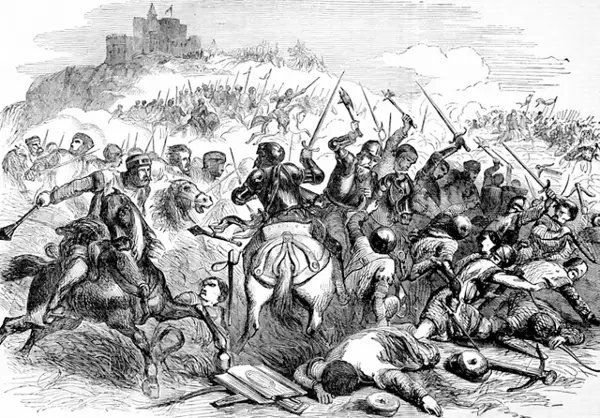The Auld Alliance between France and Scotland
 The Auld Alliance was a long-running mutual defense agreement between France and Scotland, ostensibly to counter aggression and expansion by England. The alliance was in effect, off and on, from 1295 to 1560.
The Auld Alliance was a long-running mutual defense agreement between France and Scotland, ostensibly to counter aggression and expansion by England. The alliance was in effect, off and on, from 1295 to 1560.
Scotland had successfully resisted occupation by Rome, which England and Wales had not. However, the advent of the Norman Conquest brought with it a large amount of advancement within England. Two hundred years later, Scotland was undergoing a succession crisis and England was ascendant. Scottish succession had been stable for much of the 12th and 13th Centuries. Such was not the case in 1286, when King Alexander III died. He left no clear heir who was acceptable to Scottish nobles, and the power vacuum that resulted came to be known as the Great Cause. England's King Edward I dominated the committee of 105 who had been appointed to choose the next Scottish leader, and the chosen one was John Balliol, in 1292. Balliol was King of Scotland in name but not in fact. He paid homage to Edward personally and was seen as a glorified vassal by other Scottish nobles, many of whom had opposed him during the Great Cause. Robert Bruce refused to recognize Balliol as king. The nobles regarded him as weak and ineffective. Fed up with Balliol's ineffectiveness, the Scottish nobles made their Auld Alliance with Philip IV, the king of France, in 1295 and attacked the border town of Carlisle. England's King Edward I, fearing an invasion from both France and Scotland, determined to put an end to the alliance and invaded Scotland in 1296, sacking Berwick along the way. 
English forces were also on the Continent, fighting in France, and so France wasn't in much of a position to send aid to Scotland during what came to be called the First War of Scottish Independence, led by William Wallace and Andrew Moray. Scottish forces won a few battles, most significantly the Battle of Stirling Bridge in 1297, but England struck back hard, killing Wallace and interrupting Scottish momentum for a time. Scotland eventually prevailed, however, with forces under Robert the Bruce winning their independence at the Battle of Bannockburn in 1326. As a precaution, Robert the Bruce renewed the Auld Alliance. 
This war took place against the backdrop of yet another military struggle between England and France. The king of England at this time was Edward II. He had fallen out with the new French king, his brother-in-law Charles IV, over the administration of Gascony, which had been in Edward's family possessions for many years. Preventing a military conflict was the intercession of Edward's wife, Isabella, who was Charles's sister. The resulting treaty generally favored France, but it avoided war. In the next decade, the next English king, Edward III, attempted to follow in his grandfather's footsteps but had less success. Later in the 1330s, he became much more focused on affairs on the Continent, particularly on who should sit on the throne of France. King Charles IV of France had died in 1328, and he had not left behind a male heir. Charles was Edward's uncle, and so Edward claimed that he was the heir to the French throne. Not long after Charles's death, Edward claimed the throne for himself. Edward had renewed his claim in 1337, and this is the official dating of the beginning of the Hundred Years War. That war would long outlast Edward and a handful of subsequent English monarchs. While England was preoccupied with fighting in France, a new Scottish monarch, David II, led an invasion of northern England. English forces responded adequately enough and captured David himself at the Battle of Neville's Cross, in 1346. David spent more than a decade as Edward's prisoner and had to give up a large amount of his holdings to gain his release. 
A series of subsequent rulers renewed the Auld Alliance at various times. Into the 15th Century, England and France were still contesting the Hundred Years War. In 1415, after King Henry V had led his forces to a stunning victory at Agincourt, Charles VII (the French Dauphin) reversed the normal pattern and asked Scotland for help. Scotland responded, sending more than 12,000 troops to France during the next five years. France and Scotland combined to defeat England at the Battle of Baugé in 1421. England scored a decisive victory over Scottish forces three years later, at Verneuil. A few years later, French forces enjoyed a resurgence under the famous Joan of Arc and eventually outlasted the English long enough to win the war. Scottish forces later supported the Lancastrian side during the Wars of the Roses. 
French and Scottish rulers paid nominal attention to the Auld Alliance for the rest of the 15th Century and made more of a show of formally renewing the alliance early in the 16th Century. In 1558, Scotland's Queen Mary married France's King Francis II. Two years later, however, an agreement between Francis II and England's Queen Elizabeth I ended the Auld Alliance, with the Treaty of Edinburgh. (The Scottish government had gone along with this.) In 1603, Scotland's king, James VI, became England's King James I, creating a union between England and Scotland that the 1707 Act of Union cemented. The Auld Alliance was officially at an end. A Scottish presence was still in France, however. During the Hundred Years War, a number of the Scottish troops who helped turned the tide of the war stayed on in France. Some of those joined the French monarch's group of bodyguards, the Garde Écossaise, in 1418; they and their descendants saved the lives of more than one French through the years (lasting until 1830). |
|
Social Studies for Kids
copyright 2002–2024
David White




